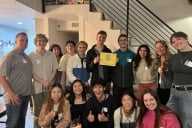You have /5 articles left.
Sign up for a free account or log in.
There are statistics that haunt the college equity community. In 1970, 6 percent of low-income students attained a B.A. by the age of 24. By 2013, this rate had indeed increased -- to 9 percent. In the meantime, 77 percent of high-income youth were graduating with a B.A., according to the Pell Institute.
Over four decades, those of us who work in higher education have tried many complex and expensive interventions in an attempt to bridge the achievement gap. Yet the inequity in college attainment stubbornly persists, leading to the growing and alarming income gap our country struggles with today.
It’s time to try something new: engaging high school students to provide the solution for closing the gap. Research and practice support the theory that the essential element of a robust college-going culture is a humming peer-to-peer network. When engaged, students can drive achievement not just for themselves individually but for all their classmates.
Studies by Laurence Steinberg of Temple University and Robert Crosnoe of the University of Texas have demonstrated that students have the greatest influence over their school culture, especially when they assist one another. In a conversation I had with Crosnoe, he argued this “instrumental assistance” holds the most promise for practice and public policy because students can be deliberately organized, empowered and coached to work on behalf of their classmates.
Though this solution begins on the K-12 side, colleges and universities also have a key role to play. They should support high schools in leveraging the power of positive peer influence.
At College Summit, we have conducted programs in more than 500 high schools to determine best practices for putting this peer-to-peer network to work. Through the College Summit PeerForward model, we train high school juniors and seniors to become peer leaders who to help their classmates learn about college, write their personal essays and file for financial aid.
There are three main pillars to our model: (1) student voice, where students are design partners and programmatic decision makers, (2) student agency, where students own their personal achievement, developing mastery through a combination of noncognitive skills and personalized learning pathways, and (3) student influence, where students assist their classmates to achieve, recognizing that they have the power and the responsibility to work on behalf of their classmates.
These programs have had a powerful impact. In a quasi-experimental study conducted by researchers from the University of Pittsburgh, schools with a peer leader team had a 26 percent higher FAFSA completion rate than comparable schools without a peer-to-peer strategy.
This empirical result derives from the ingenuity of the youth themselves. I have been privileged to observe students in urban and rural high schools lead their classmates to college. I’ve seen students lock the senior class in a gym until they have completed their state college applications.
When college representatives refused to come to a high school, I saw a group of students themselves represent the colleges in the cafeteria. In Detroit, a team of high school students negotiated utility bill credits for families who completed the FAFSA. In rural Florida, I watched a team of 11th and 12th graders run an assembly for 1,500 students like it was a revival meeting, exhorting the entire school to commit to going to college. And I’ve seen a team of 12th graders help reduce their school’s ninth-grade dropout rates by adopting and coaching at-risk, first-year high school students to envision their personal purpose and stay in school.
A staff member of Detroit Edison Public School Academy described the impact: “These students have made such a difference in our school. Watching them work with the rest of the students -- almost as surrogate counselors -- has made me understand what a valuable resource I have. They have created a real culture of college-going.”
After witnessing the transformative power of high school juniors and seniors guiding their peers to higher education, we have decided to focus exclusively on developing and deploying these peer leaders in our partner schools, with the aim of placing 1,000 peer-leader teams in 1,000 high schools in the coming decade.
Colleges that support the role of high school student engagement will not only be helping to solve a national emergency but also creating a pipeline of talent for their institutions, as we have seen in many College Summit partner colleges. I urge colleges to reach out to high schools to help them assemble a team of students to ensure that all of their classmates are navigating the pathway to a higher education degree.
Ramon Gomez, a 2010 College Summit peer leader from Inglewood High School in Los Angeles, sums this mind-set up best. Now a graduate of the University of California, Los Angeles, he still aims, in his words, “to embody” the mission of “giving all students from all backgrounds the opportunity to obtain a higher education” so that young people can “realize how golden [they] truly are.”








